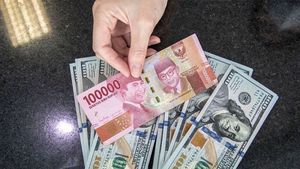JAKARTA - President Joko Widodo (Jokowi) received a complaint from garlic farmers in Temanggung: the faucet for imported garlic was opened at harvest time. Protectionism does play an important role here. It's just that upstream problems such as increasing productivity must also be taken care of.
The moment that Jokowi called the Minister of Trade (Mendag) Muhammad Lutfi during a working visit to Temanggung, Central Java, became a conversation. In his conversation, the former Governor of DKI Jakarta had time to ask why the import of garlic actually entered during the harvest season.
"Mr. Minister, I'm with garlic farmers in Temanggung," said Jokowi, as the title of the post showed Jokowi on the phone. "Their complaints are all the same. At harvest time, garlic imports come in. They always complain."

Unfortunately, reducing or closing the import tap is even the right way out. Economist Institute for Development of Economics and Finance (Indef) Nailul Huda told VOI, Indonesia is still dependent on imports for garlic.
Although in terms of aroma and taste, local garlic is superior, but imported garlic is still the prima donna, one of which is because of its larger shape. This was revealed by Fachru Nasution, an exporter who was once a chef.
According to this person who has been in the culinary industry for years, the smaller size of garlic is quite difficult in the cooking process. "That's why the culinary industry uses imported garlic more," he told VOI.
Fachru said, actually in terms of taste quality, local garlic is indeed the champion. However, the size factor turned out to be quite important to be considered by the culinary industries, besides the lower price of course.
Fachru also said that he had received a request to export garlic to Oman. However, he again said that local garlic only lost in terms of size. "But what they are looking for is garlic that is exactly like imported garlic in Indonesia. Obviously we can't fulfill this demand."
For this reason, he hopes that the government, especially the Ministry of Agriculture, is serious about fostering and developing the productivity of Indonesian farmers. "In order to create varieties of garlic which in terms of size are not inferior to imported garlic."

Economist Nailul Huda agrees that in terms of productivity, our garlic commodity is far behind. For example from China. At least that's what makes garlic from Bamboo Curtain Country cheaper.
"Compared to local garlic which has low productivity, therefore the price is more expensive. Even though the quality is better locally, consumers still choose cheaper ones," said Huda.
The productivity referred to by Huda includes issues of technology, labor prices, seed prices, fertilizer prices, and so on. "In our case, the most costs are for labor. So, it is less efficient."
Therefore, this homework rests on the Ministry of Agriculture. Because most of the problems are in production, not distribution.
"The problem is in the production, not the distribution. The Ministry of Agriculture is responsible for production."
As an illustration, according to data from the Central Statistics Agency (BPS), garlic production in Indonesia has never reached one hundred thousand tons in a year. In 2020 alone, production will only reach 81.80 thousand tons. That number even decreased by 7.89 percent compared to 2019 which reached 88.82 thousand tons.
Meanwhile, according to the Ministry of Agriculture, the demand for garlic in 2021 will reach 532 thousand tons. This is what makes the need for imports of garlic difficult to avoid.
*Read other information about AGRICULTURE, read another interesting article from Ramdan Febrian Arifin.
Other BERNASThe English, Chinese, Japanese, Arabic, and French versions are automatically generated by the AI. So there may still be inaccuracies in translating, please always see Indonesian as our main language. (system supported by DigitalSiber.id)









